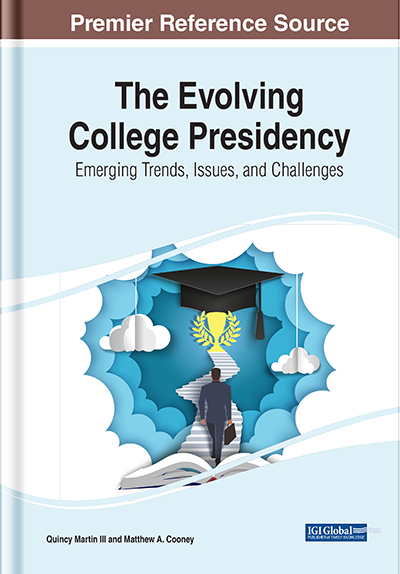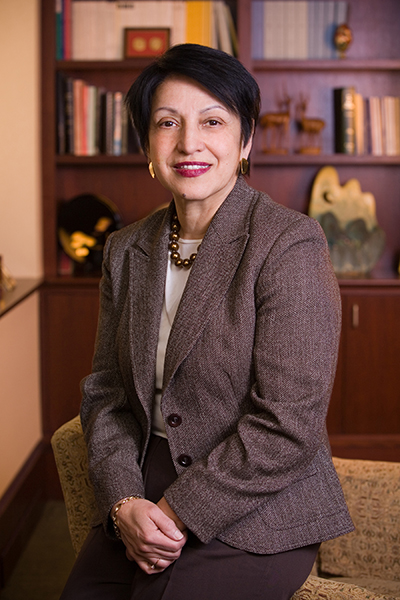- Apply
- Visit
- Request Info
- Give



Published on June 15, 2023
 Improving access to higher education for underrepresented students will help ensure future economic prosperity and social stability, explains Eastern Connecticut State University President Elsa Núñez in a new book titled “The Evolving College Presidency: Emerging Trends, Issues and Challenges.”
Improving access to higher education for underrepresented students will help ensure future economic prosperity and social stability, explains Eastern Connecticut State University President Elsa Núñez in a new book titled “The Evolving College Presidency: Emerging Trends, Issues and Challenges.”
Published by IGI Global in 2022, “The Evolving College Presidency” brings together a collection of college and university presidents and administrators who co-author an anthology on the dynamics facing today’s higher education landscape.
“Nothing can be more important on the agenda of college and university presidents in this country than addressing the access issue,” Núñez wrote in her chapter titled “Balancing Access and Quality: The Ultimate Presidential Challenge.”
But access is only half of the equation, she notes, with students graduating as the ultimate measure of success. “University presidents do underrepresented students no favors when we expand access to college campuses without providing the necessary additional supports that students need to succeed.”
To the desired outcome of improved economic opportunity and social mobility, Núñez pointed to a study by McKinsey & Co. that found if Latinos and African Americans were to graduate from college at the same rate as white students in Connecticut, they would generate $5 billion to $8 billion in income and provide the state with hundreds of millions of dollars in additional tax revenue.
Núñez described two programs at Eastern that have improved access and graduation rates for Black and Latino students, groups that have lagged in college attendance in Connecticut and, in some cases for Latinos, have been locked out of colleges in other states. She decried lumping students into “minority” categories, however, noting the diversity within these categories and the importance of treating students as individuals as well as equal members of their university communities.
In 2009 the National Assessment of Educational Progress (NAEP, the “nation’s report card”) found that the gap in test scores between Connecticut’s wealthiest suburbs and its poorest city neighborhoods was the largest among all 50 states. That created challenges when, as a new college president in 2006, Núñez sought to recruit students from the large Latino community in Willimantic and from Hartford High School, where less than 5% of the class of 2003 was projected to graduate from a four-year college by 2008.

Over two years Eastern developed a program, the Dual College Enrollment Program (DCEP), to recruit and retain these students, providing them with the support they would need to succeed in college.
The students took foundational courses at the nearby Quinebaug Valley Community College in their first-year fall semester, then enrolled as full-time students at Eastern in the following spring semester. They lived on campus and were housed throughout the campus rather than being isolated in special dormitories, fully integrated among the student body. An “Academic Success Center” located in the library provided tutoring and advising. They were also encouraged to join clubs and take advantage of on- and off-campus internships.
“The more engaged they were in such applied learning experiences, the more successful they were in achieving their academic goals, evidenced by higher GPAs and better graduation rates,” wrote Núñez.
Students participating in the program became campus leaders and went on to graduate school or professional careers. About 40% of DCEP participants have graduated from Eastern or another college. In 2012, a study by the national Education Trust ranked Eastern number one among public colleges and universities in the improvement of its six-year graduation rate for Latino students. In 1998, the rate was 20% at Eastern; by 2010, it had reached nearly 58% .
The second program Núñez describes to recruit underrepresented students is Eastern’s partnership with TheDream.US, a privately funded scholarship program for undocumented students founded by Donald Graham, former publisher of the Washington Post.
TheDream.US provides scholarships to DACA students who have been denied access to college in states such as Georgia, Wisconsin and others. In 2016, Eastern became one of only two colleges to pilot the program’s “Opportunity Scholars” Since then, more than 300 undocumented students have enrolled at Eastern through the program, and Eastern remains TheDream.US’s largest campus partner.
Students in the program have excelled academically and as student leaders, Núñez noted. “Eastern’s campus has been strengthened and enriched by the presence of these undocumented students,” she wrote. Of the first class of 47 students, 46 graduated, and they had an average GPA of 3.5.
Improving access does not mean sacrificing academic rigor, Núñez said. “You don’t have to water down your academic standards or the quality of the education you provide to serve students who need greater support. Lift them up instead,” she wrote.
The keys to making access programs work are to have the recruited students live on campus, to help them fit into the campus culture, and to use data to inform decisions and deliver services, Núñez wrote.
“No campus can solve the issue of social injustice on its own, but instead must focus on supporting each student as an individual,” she said.
For more information on “The Evolving College Presidency” and to purchase, visit https://www.igi-global.com/book/evolving-college-presidency/288796 . Use code IGI50 for 50% off the purchase price until July 31. Thereafter the discount will lower to 35% with promo code IGI35.
Written by Cindy Weiss and Michael Rouleau